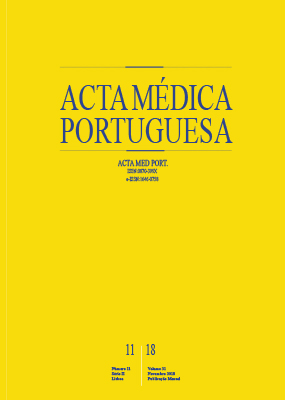Histological Subtypes and Clinical Behavior Evaluation of Salivary Gland Tumors
DOI:
https://doi.org/10.20344/amp.9023Keywords:
Salivary Gland Neoplasms/pathology, Salivary Glands/pathologyAbstract
Introduction: Salivary gland tumors include a wide spectrum of histological subtypes and clinical behavior, which we aim to evaluate.
Material and Methods: We performed a retrospective study of all salivary gland tumors diagnosed and treated at the Centro Hospitalar São João, Porto, between 2005 and 2015. Histological re- evaluation was performed in all cases and patient files were reviewed and both clinical and follow-up data were collected. Disease-free survival and overall survival were evaluated using Kaplan-Meier survival curves and compared using the Mantel-Cox log-rank test. The significance threshold was set at 0.05.
Results: We selected 295 cases, 150 males with a mean age at diagnosis of 50.4 (± 16.4) years. Primary benign epithelial tumors [n = 228 (77.3%)] were mostly pleomorphic adenomas [n = 148 (64.9%)] and Warthin tumors [n = 61 (26.8%)]. Primary malignant epithelial tumors [n = 43 (14.8%)] included mucoepidermoid [n = 16 (37.2%)], adenoid cystic [n = 6 (14.0%)] and acinic cell [n = 5 (11.6%)] carcinomas; 32 (74.4%) in parotid, 2 (4.6%) in submandibular and 9 (21%) in minor salivary glands. Primary epithelial tumors were more frequently malignant in minor (33.3%) than in major (13.9%) salivary glands. Local recurrence occurred in 30.2% and distant metastases in 25.6% tumors. The mean disease-free interval was 26 (± 37.5) months; most metastases were in lung and central nervous system. The 5 and 10 year disease-free survival rates were 63.4% and 50.1%, respectively; the 5 and 10 year disease-specific survival rates were 76.9% and 57.9%, respectively. Primary salivary tumors included also lymphomas [n = 8 (2.7%)] and soft tissue tumors [n = 5 (1.7%)]. Secondary tumors included metastases of carcinomas [n = 7 (2.4%)] and involvement by lymphoma [n = 1 (0.3%)].
Discussion: Our results concerning age, gender, histological subtype, frequency and clinical behavior of salivary tumors concur with European studies. Divergence with Portuguese studies might be related with the inclusion criteria, clinical referral and time lag variations.
Conclusion: Although uncommon, salivary gland tumors occur in a wide age range and include histological subtypes with diverse prognosis.
Downloads
Downloads
Published
How to Cite
Issue
Section
License
All the articles published in the AMP are open access and comply with the requirements of funding agencies or academic institutions. The AMP is governed by the terms of the Creative Commons ‘Attribution – Non-Commercial Use - (CC-BY-NC)’ license, regarding the use by third parties.
It is the author’s responsibility to obtain approval for the reproduction of figures, tables, etc. from other publications.
Upon acceptance of an article for publication, the authors will be asked to complete the ICMJE “Copyright Liability and Copyright Sharing Statement “(http://www.actamedicaportuguesa.com/info/AMP-NormasPublicacao.pdf) and the “Declaration of Potential Conflicts of Interest” (http:// www.icmje.org/conflicts-of-interest). An e-mail will be sent to the corresponding author to acknowledge receipt of the manuscript.
After publication, the authors are authorised to make their articles available in repositories of their institutions of origin, as long as they always mention where they were published and according to the Creative Commons license.









